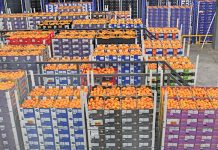
We live in an ever-changing world where consumers are constantly introduced to a wider range of options and novel products. If the citrus industry doesn’t follow this trend, consumers might start seeing it as unimaginative and unexciting.
This is why growers must regularly introduce new varieties, says Etienne Rabe of Biogold USA and Paramount Citrus, who addressed the Global Citrus Conference in Cape Town recently. South Africa is already one of the world’s foremost producers and exporters of quality citrus produce, and introducing new varieties would see the sector expand even further.
“Valencia and navel oranges currently account for 67% of citrus hectarage in South Africa, which is ranked 12th in the world for production volumes and is second only to Spain when it comes to export volumes,” says Etienne.
The future of the citrus market
Etienne points to the mandarin market, where a number of seedless or low-seeded selections have emerged over the past 10 years. He predicts these new selections will cause a major shift in plantings, possibly to the detriment of other late navel varieties like Valencias.
“I’d guess that seedless or low-seeded mandarins could account for up to 25% of the fresh-citrus market in about 10 years,” he predicts. South African producers have already responded to this new demand by introducing the Nadorcott (also known as Afourer or ClemenGold).
“A large area has been established of this variety,” Etienne explains. “It fills a very important late-maturing sector (July to September) of the business in Europe and other northern hemisphere countries. The same applies to other late mandarin-types such as Orri and Mor.”
But, he adds, because citrus trees are long-lived and replanting is expensive, it’s unlikely there will be a large-scale overnight change. Another thing to bear in mind is that there aren’t necessarily new varieties to replace the older ones in every sector and time frame of the season. All the same, Etienne says, variety management companies in South Africa are always on the look-out for new varieties that will benefit growers and keep the industry competitive.
Consumer wants, producer needs
“A lot of citrus is grown around the world and there’s no shortage. That’s why I believe eating quality will become more important for consumers,” says Etienne.
“In the past, larger fruit sizes always paid better and growers or regions with better eating quality didn’t always get a look-in. But this should change.
“Growers need to gear themselves to produce fruit that tastes better in a market that’s not just oversupplied with citrus. But where there are many other exciting fresh fruit offerings available to the consumer,” says Etienne.
This means growers need to keep their eyes open for new varieties that will naturally produce fruit of good eating quality. That’s in addition to other consumer “favourites” like seedlessness and easy peeling.
However, when introducing new varieties, producers have to make sure these fit into their management philosophy. Other considerations also come into play, such as higher yields, better colour and good post-harvest shelf-life.
“It’s important to consider whether or not the management company offering the selection has the technical capacity to address production issues and generally assist in ensuring successful commercialisation when it comes to marketing,” says Etienne.
“How will the variety be managed? Through grower clubs or controlled hectarage? What are the rootstock choices?”
Another issue is to ensure that only growers who have paid the necessary royalties and are licensed to produce a specific variety get to produce that fruit, and that rogue growers are prosecuted. Technology can help here. Tracing systems and fruit “tattoos” ensure supermarkets only accept genuine varieties.
Future superstar varieties
“There are a few new selections in the pipeline and some that are being commercialised that fit the ‘future superstar’ designation,” says Etienne.
“One is an early navel selection from Australia, the M7, which is becoming available to growers in South Africa. It colours early with good internal eating quality and is a round fruit, unlike most early navels which are somewhat elongated.”
Then there are a number of new seedless Valencias, such as Lavalle, Alpha and Mclean, and late-maturing navels, such as Cambria and Glen Ora, as well as a seedless lemon from the Agricultural Research Council-Institute for Tropical and Subtropical Crops (ARC-ITSC), South Africa.
A risk worth taking
“When introducing a new citrus selection or variety, farmers always run the risk it won’t perform as well as advertised,” warns Etienne. There’s also the possibility of over-planting if the distribution of the plant isn’t controlled by limiting acreage.
“But if you’re a progressive grower, you can’t afford to sit on the sidelines and calculated risks have to be taken,” he says. “The most important thing is that the management and royalty structure reasonably assures the grower the risk will pay off.”
Contact Etienne Rabe at [email protected].













